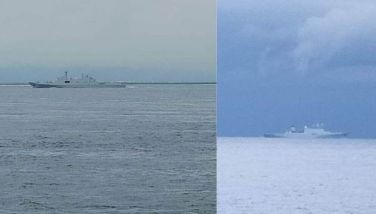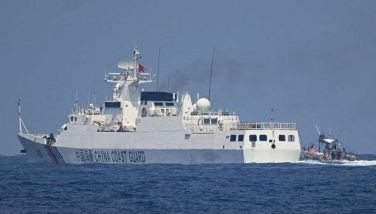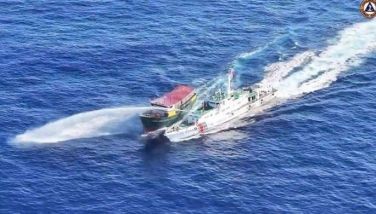In the present Tence

March 12, 2006 | 12:00am
It seems no coincidence that the opening of the artist Jose Tence Ruiz’s 30-year retrospective of new and old works occurred on the same day a state of emergency was declared, also the eve of the 20th anniversary of the ouster of a dictator: while cities were abuzz with coup plots, loyalty checks, suspension of classes, there was a pocket of calm at the Artwalk of Megamall for art that is truly revolutionary.
Organized by Finale Art File, Tence Ruiz’s "BoDeGa (Mga Bago’t Dating Gawa)" gives a sweeping panorama of the artist/sculptor/illustrator’s development since his late teens as a Fine Arts student at the University of Sto. Tomas, through his forays into the journalistic world as editorial cartoonist and illustrator for the Manila Chronicle and Manila Times including sojourns abroad in the controlled state of Singapore for the Straits Times where he branched out into performance art in his spare time; up to the present creeping middle age (Bogie, as he is called, turns 50 this year) where he continues to astound and astonish as much with his subjects as with the materials he uses and combines: digital laminate with the more conventional acrylic and other cost-friendly found objects.
We always knew that he was good, but now, seeing Tence’s selected works over the past three decades suddenly hits us like a brick or yet another found object on the head that makes us finally realize that here is art that would be ignored at our own peril: not unlike the masters before and after him, his work carves out a special niche in space and time, in a veritable capsule that serves as both conscience and provocateur of our preconceived notions of beauty, truth, religion, sex, communism, and other faiths.
Seeing his work now live, and as the saying goes all day 24 hours a day because you asked for it we’re giving it to you, we are short of dumbfounded by his sculpture works, at least two of which ran off with the top prize in the annual competition of the Art Association of the Philippines. As conceptual artist, Tence harnesses both what is familiar with the Pinoy jeepney riding everyman, as well varied transpositions into the postmodern realm of deconstruction of the French philosophers.
In Yelado we have an icebox filled not with beer but with pink stuff we fear could be likenesses of preserved fetuses; in his two tributes to the jeepney we glimpse some references to Dalena in his humanist hyperrealism, the dirt and grime and rococo concerns captured as is; the Paraisado series as depicted in a humble cariton and an ice cream vendor’s wares (Sorbetero) overrun with church spires of an abiding faith against poverty’s overwhelming odds.
Perhaps more familiar with the newspaper reading public is Tence’s editorial cartoons with varied newspapers and magazines in the dying years of martial law and into the first heady years after the first EDSA revolt, which the cartoonist treats with a sobering surrealism and humor that go beyond social commentary, because the subjects now on hindsight become archetypes: coup plotters, assorted scary monsters, and the unforgettable image of the beggar child watching the wang-wang cars with their riders flashing the Laban sign and declaring freedom from Marcos and tyranny, thinking, "and... I hope... Poverty."
That the last mentioned cartoon came out 20 years ago and is still relevant today could signal that Filipinos are slow learners, and EDSA is a largely unfinished (as per the Catholic bishops) if not hypothetical revolution.
In Singapore while working at the Straits Times in the 1990s Tence began to experiment with other mediums and material available to the artist in a technologically advanced setting, in particular digital and computer art which, however, he approached with an old school, almost conventional mindset. Yet he puts all these to good use because everything is fair game to art, though the surfaces may be somewhat slick due to the laminate: "Viva la Debolusyon," for one, strikes one as a weary reminder of Rizal in the age of wires, a kind of sermon on the mount of controlled, cluttered mayhem.
In Singapore too Bogie experimented with performance art, such as "Licence" performed into the New Year of 1994 in an art gallery in the island state, and the mind- numbing "Without it I am Invisible" performed in buses and other public conveyance vehicles, and which could have been a culmination of a long festering work: in his studio in the San Miguel district in the 80s, Tence dabbled in creating mummy-like figures, which have an uncanny resemblance to the bandage-covered commuters wearing shades in the Singapore buses.
Not to be outdone either are his large works on canvass, such as the Manananggal series, one legend of which is memorable with a half body on an exercise treadmill, against a backdrop of bright yellow green one would perhaps normally see in the south of France.
Again here the artist is not merely being avant-garde; it’s second nature for him to juxtapose local mythology with the ambiance of a world we’d only seen in picture books and postcards.
It is only fitting that BoDeGa includes works that germinated at the UST Fine Arts and Architecture building: "Aloofness" that has a starched collar of polo shirt sticking out of the canvass, and "Mahirap Magpalaki ng Sarili" with its blurred lines of an abstract, anti-self portrait, exhibit the teenage abstractions of another great angst in the making, and hint at the eventual grandness of the artist’s vision.
Organized by Finale Art File, Tence Ruiz’s "BoDeGa (Mga Bago’t Dating Gawa)" gives a sweeping panorama of the artist/sculptor/illustrator’s development since his late teens as a Fine Arts student at the University of Sto. Tomas, through his forays into the journalistic world as editorial cartoonist and illustrator for the Manila Chronicle and Manila Times including sojourns abroad in the controlled state of Singapore for the Straits Times where he branched out into performance art in his spare time; up to the present creeping middle age (Bogie, as he is called, turns 50 this year) where he continues to astound and astonish as much with his subjects as with the materials he uses and combines: digital laminate with the more conventional acrylic and other cost-friendly found objects.
We always knew that he was good, but now, seeing Tence’s selected works over the past three decades suddenly hits us like a brick or yet another found object on the head that makes us finally realize that here is art that would be ignored at our own peril: not unlike the masters before and after him, his work carves out a special niche in space and time, in a veritable capsule that serves as both conscience and provocateur of our preconceived notions of beauty, truth, religion, sex, communism, and other faiths.
Seeing his work now live, and as the saying goes all day 24 hours a day because you asked for it we’re giving it to you, we are short of dumbfounded by his sculpture works, at least two of which ran off with the top prize in the annual competition of the Art Association of the Philippines. As conceptual artist, Tence harnesses both what is familiar with the Pinoy jeepney riding everyman, as well varied transpositions into the postmodern realm of deconstruction of the French philosophers.
In Yelado we have an icebox filled not with beer but with pink stuff we fear could be likenesses of preserved fetuses; in his two tributes to the jeepney we glimpse some references to Dalena in his humanist hyperrealism, the dirt and grime and rococo concerns captured as is; the Paraisado series as depicted in a humble cariton and an ice cream vendor’s wares (Sorbetero) overrun with church spires of an abiding faith against poverty’s overwhelming odds.
Perhaps more familiar with the newspaper reading public is Tence’s editorial cartoons with varied newspapers and magazines in the dying years of martial law and into the first heady years after the first EDSA revolt, which the cartoonist treats with a sobering surrealism and humor that go beyond social commentary, because the subjects now on hindsight become archetypes: coup plotters, assorted scary monsters, and the unforgettable image of the beggar child watching the wang-wang cars with their riders flashing the Laban sign and declaring freedom from Marcos and tyranny, thinking, "and... I hope... Poverty."
That the last mentioned cartoon came out 20 years ago and is still relevant today could signal that Filipinos are slow learners, and EDSA is a largely unfinished (as per the Catholic bishops) if not hypothetical revolution.
In Singapore while working at the Straits Times in the 1990s Tence began to experiment with other mediums and material available to the artist in a technologically advanced setting, in particular digital and computer art which, however, he approached with an old school, almost conventional mindset. Yet he puts all these to good use because everything is fair game to art, though the surfaces may be somewhat slick due to the laminate: "Viva la Debolusyon," for one, strikes one as a weary reminder of Rizal in the age of wires, a kind of sermon on the mount of controlled, cluttered mayhem.
In Singapore too Bogie experimented with performance art, such as "Licence" performed into the New Year of 1994 in an art gallery in the island state, and the mind- numbing "Without it I am Invisible" performed in buses and other public conveyance vehicles, and which could have been a culmination of a long festering work: in his studio in the San Miguel district in the 80s, Tence dabbled in creating mummy-like figures, which have an uncanny resemblance to the bandage-covered commuters wearing shades in the Singapore buses.
Not to be outdone either are his large works on canvass, such as the Manananggal series, one legend of which is memorable with a half body on an exercise treadmill, against a backdrop of bright yellow green one would perhaps normally see in the south of France.
Again here the artist is not merely being avant-garde; it’s second nature for him to juxtapose local mythology with the ambiance of a world we’d only seen in picture books and postcards.
It is only fitting that BoDeGa includes works that germinated at the UST Fine Arts and Architecture building: "Aloofness" that has a starched collar of polo shirt sticking out of the canvass, and "Mahirap Magpalaki ng Sarili" with its blurred lines of an abstract, anti-self portrait, exhibit the teenage abstractions of another great angst in the making, and hint at the eventual grandness of the artist’s vision.
BrandSpace Articles
<
>
- Latest
- Trending
Trending
Latest
Trending
Latest
Recommended


















